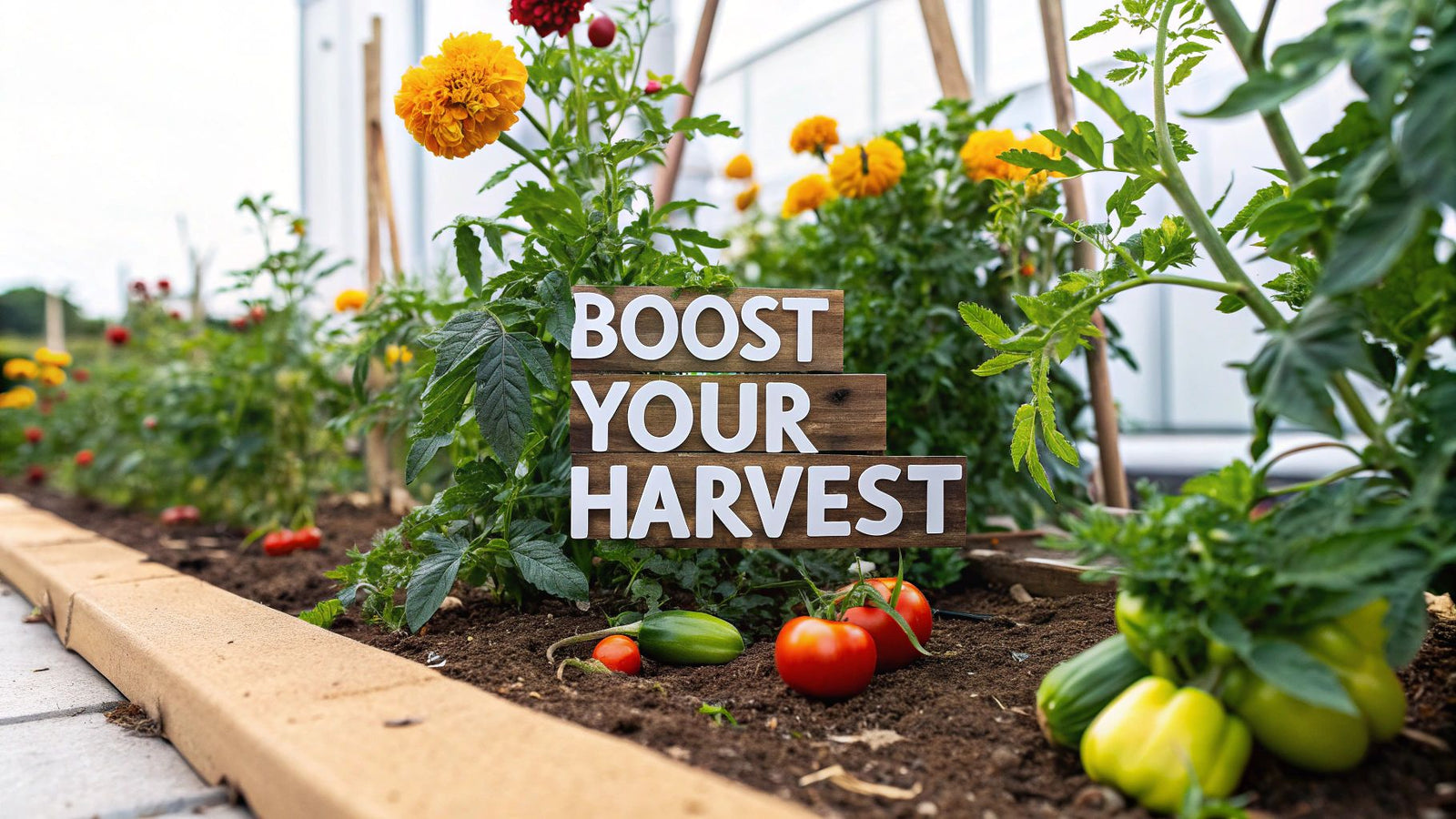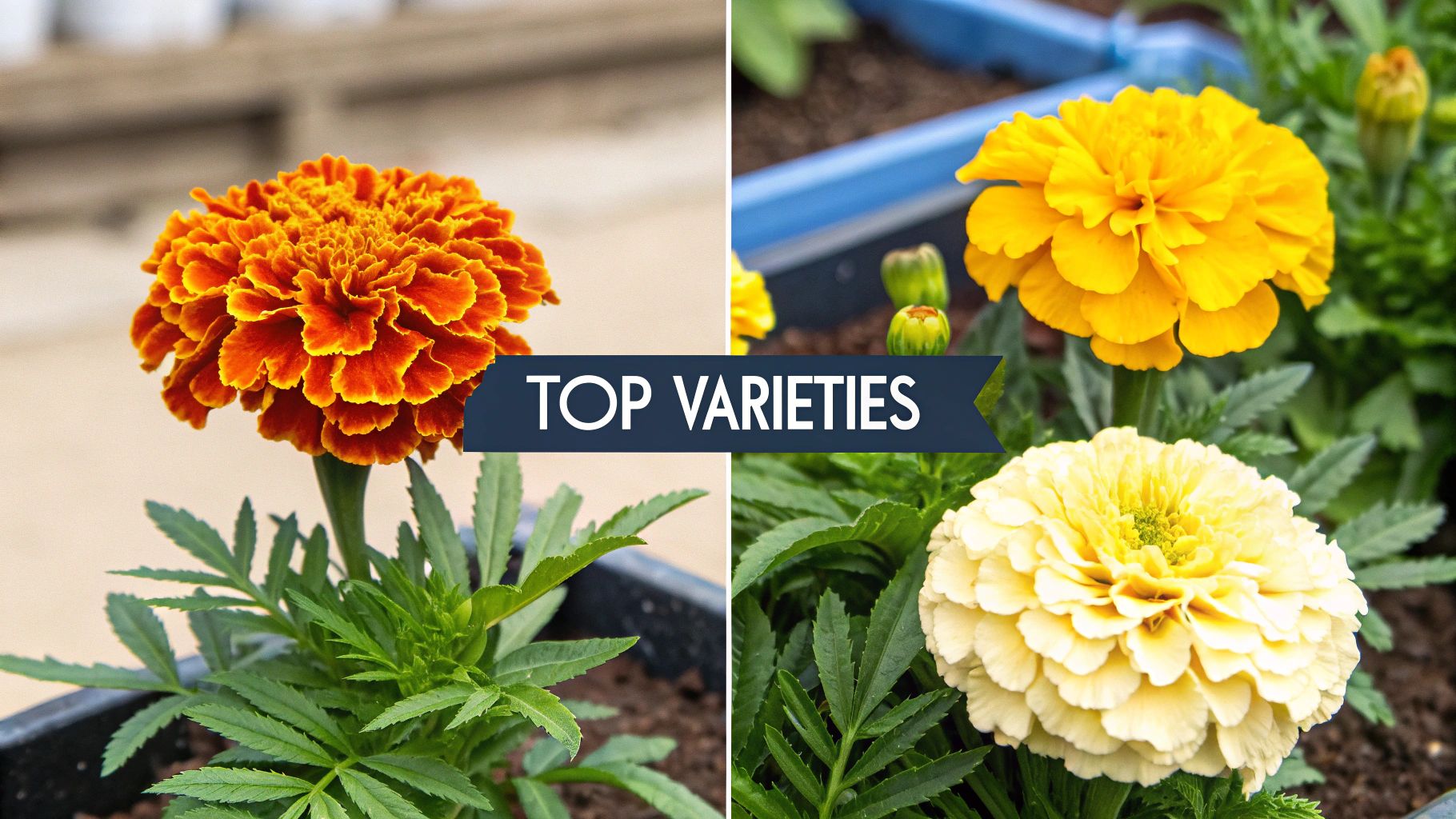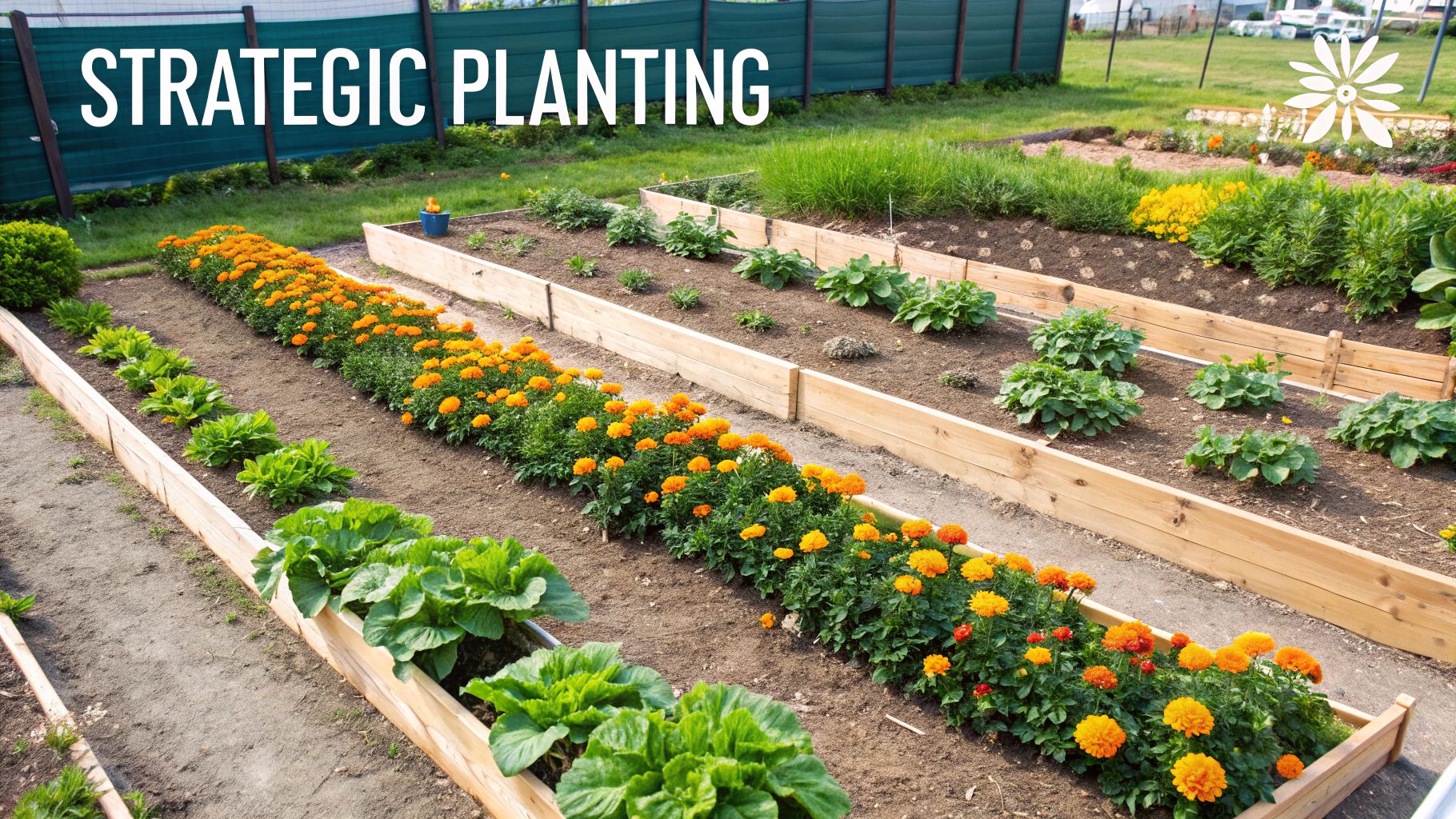
If you've ever walked through a seasoned gardener's vegetable patch, you've probably noticed rows of cheerful marigolds tucked in among the tomatoes and beans. This isn't just for looks. Pairing marigolds and vegetable gardens is a classic, time-tested strategy for a healthier, more productive harvest. Think of these flowers as your garden's hardest-working employees; they're not just there to be pretty, they actively protect your vegetables and improve the soil they live in.
7 Key Benefits of Planting Marigolds with Vegetables
If you've ever walked through an old-timer's vegetable patch, you've probably seen bright pops of orange and yellow tucked between the tomatoes and beans. Planting marigolds in your garden is one of the smartest (and prettiest) things you can do for a healthier, more bountiful harvest.
This isn't just about looks. These cheerful flowers are serious workhorses, acting as tiny guardians for your vegetables. Let's dive into the seven biggest reasons why marigolds are a vegetable gardener's best friend.
1. They Fight Nematodes Under the Ground
One of the most powerful benefits of marigolds happens completely out of sight, right in the soil. Many gardens struggle with root-knot nematodes—microscopic worms that feast on plant roots, leaving your vegetables stunted and weak.
French marigolds (Tagetes patula) are the real champions here. Their roots release a natural chemical that is toxic to these tiny destroyers. This process, called allelopathy, creates a protective barrier in the soil, shielding the roots of your tomatoes, peppers, and squash from attack.
2. They Keep Common Garden Pests Away
You know that sharp, almost spicy smell marigolds have? A lot of bugs absolutely hate it. That strong scent acts like a natural force field, confusing insects and making it difficult for them to even find your vegetables in the first place.
This smelly shield works wonders against some of the worst garden villains:
- Tomato Hornworms: These giant caterpillars can devour a tomato plant practically overnight, but they often steer clear of plants surrounded by marigolds.
- Cabbage Moths: Tuck some marigolds near your broccoli, kale, and cabbage to help convince these moths to lay their eggs elsewhere.
- Mexican Bean Beetles: These pests can skeletonize bean leaves, but interplanting marigolds can dramatically cut down on the damage.
This infographic lays out the whole strategy, from protecting the soil below to managing the ecosystem above.

As you can see, it's a layered defense system. Marigolds tackle threats underground, ward off bad bugs, and invite the good ones, creating a beautifully balanced garden.
3. They Discourage Larger Animals
It’s not just the little critters that marigolds help with. Their pungent smell can also be a major turn-off for larger animals that can destroy a garden bed in minutes.
Rabbits and deer, in particular, tend to avoid areas planted heavily with marigolds. According to the University of Minnesota Extension, gardens with marigolds can see up to 40% less damage from these animals. In the US, deer and rabbits cause over $2 billion in agricultural damage each year, so a few flowers can make a huge difference. You can find more great tips on using plants to protect your garden from the University of Minnesota Extension.
Think of it this way: planting a thick border of marigolds around your garden is like building a "scent fence." It makes your vegetable patch a much less tempting buffet for furry pests.
4. They Bring in the Good Guys (Pollinators!)
While pests can't stand the smell, pollinators find marigolds irresistible. The bright, open-faced flowers are a beacon for bees, butterflies, and other helpful insects looking for a meal.
This is a massive win for your garden. Having more pollinators zipping around means your flowering vegetables—like squash, cucumbers, melons, and tomatoes—get the attention they need. More pollination directly leads to more fruit, which means a bigger harvest for you. For more tips on garden protection, check out our guide on how to keep pesky pests at bay.
5. They Can Be a "Trap Crop"
Here’s a clever trick: some pests are actually attracted to marigolds. While that sounds bad, you can use it to your advantage with a strategy called trap cropping.
Slugs, for example, sometimes prefer munching on marigolds over your lettuce. By planting a small, sacrificial patch of marigolds away from your main crops, you can lure the slugs to one spot. This makes them easy to find and deal with before they ever get to your prized greens.
6. They Attract Your Garden's Bodyguards
Marigolds don't just attract pollinators; they also roll out the welcome mat for predatory insects. These are the good bugs that act like a personal security team for your garden, hunting down and eating pests.
Some of the top defenders you'll see around marigolds include:
- Ladybugs: Famous for their unending appetite for aphids.
- Lacewings: Their tiny larvae are known as "aphid lions" for a reason—they devour aphids, mites, and other pests.
- Hoverflies: Don't let their bee-like appearance fool you. Their larvae are fantastic aphid-eaters.
By giving these predators food and shelter, you're building a garden that can defend itself. This natural balance means less work for you and no need for harsh chemical sprays.
7. They Help Suppress Weeds and Build Soil
Last but not least, marigolds help you win the war against weeds. When you plant them densely, their bushy leaves create a living mulch that shades the soil. This prevents weed seeds from getting the sunlight they need to sprout.
When the season is over, don't just pull them out! As long as the plants are disease-free, you can chop them up and till them right back into the garden bed. This adds valuable organic matter, improving your soil's structure for next year. Plus, as the plant material breaks down, it continues releasing those nematode-fighting compounds right where you need them.
5 Best Marigold Varieties for Pest Control

When you decide to plant marigolds in your vegetable garden, it's easy to assume any old variety will work just fine. And while it's true that all marigolds offer some benefits, a few specific types are absolute powerhouses for pest control. Picking the right one is like choosing the perfect tool for a job—it simply makes all the difference.
You see, not all marigolds are created equal when it comes to their pest-fighting abilities. Some are champions at battling unseen enemies in the soil, while others create a pungent barrier that sends airborne pests flying in the other direction. Let's dig into the top five varieties so you can match the perfect marigold to your garden's unique challenges.
1. French Marigolds (Tagetes patula)
If there's one villain in the vegetable garden, it’s the root-knot nematode. These microscopic worms are notorious for attacking the roots of tomatoes, peppers, and squash, leading to stunted plants and disappointing harvests. When it comes to this underground fight, French marigolds are the undisputed champions.
Their roots exude a potent natural compound called alpha-terthienyl, which is lethal to nematodes. This makes them the absolute best choice for interplanting directly with your most vulnerable veggies.
- Key Strength: Unmatched control of root-knot nematodes.
- Best Placement: Tucked in and around tomatoes, peppers, squash, and beans.
- Growth Habit: They're typically compact and bushy, growing 6 to 12 inches tall. This size is perfect for borders and planting between rows without casting too much shade.
2. African Marigolds (Tagetes erecta)
Standing taller and more commanding than their French cousins, African marigolds boast huge, pom-pom-like flowers and a particularly strong scent. It’s this powerful aroma that makes them so good at warding off a whole host of above-ground pests.
Their fragrance can confuse insects like cabbage moths and Mexican bean beetles, making it much harder for them to find their favorite plants. They’re fantastic for creating a tall, protective "scent fence" around the entire perimeter of your garden.
Think of African marigolds as the watchtowers of your garden. Their height and powerful fragrance provide a first line of defense, warning flying pests to steer clear of your prized vegetables.
Popular varieties like the Crackerjack mix produce enormous, vibrant blooms that are as beautiful as they are effective. If you're interested in growing this impressive variety, our Crackerjack marigold grow guide provides all the details you need for stunning results.
3. Signet Marigolds (Tagetes tenuifolia)
Signet marigolds are a little different. With their delicate, lacey foliage and a profusion of small, single-petaled flowers, they look much daintier than other varieties. But don’t let their appearance fool you; they are fantastic at attracting beneficial insects.
While they do offer some pest deterrence, their main job is to invite the good guys—pollinators and predatory insects—into your garden. As a bonus, their flowers have a lovely citrusy scent and are edible, making for a beautiful and tasty addition to summer salads.
- Key Strength: Attracting beneficial insects like hoverflies and parasitic wasps.
- Best Placement: Scattered throughout the garden to create little hubs of activity for "good bugs."
- Growth Habit: They have a mounding, airy habit that fills spaces beautifully without becoming too dense.
4. Mexican Marigolds (Tagetes lucida)
Also known as Mexican Tarragon or Mint Marigold, this variety is a true multi-tasker. It has a sweet, anise-like fragrance that is known to repel a variety of pests, especially the incredibly annoying whitefly.
Beyond pest control, it's also a fantastic culinary herb that serves as an excellent substitute for tarragon. Planting Mexican marigolds gives you both a natural pest solution and a fresh herb for your kitchen—a perfect two-for-one deal for any gardener.
5. Triploid Marigolds (Tagetes patula x erecta)
What do you get when you cross the nematode-fighting power of a French marigold with the size and scent of an African marigold? You get a Triploid hybrid. These sterile hybrids are absolute workhorses that pour all their energy into producing massive, vibrant blooms all season long.
Since they don't set seed, they flower continuously without any need for deadheading. This non-stop blooming provides a constant scent barrier and a long-lasting nectar source, offering the best of both worlds for the busy gardener.
Comparing Top Marigold Varieties for Vegetable Gardens
Choosing the right marigold can feel overwhelming, but it really comes down to identifying your primary garden pest or goal. This table breaks down the strengths of each variety to help you make the best choice for your plot.
| Marigold Variety | Primary Pest Target | Typical Height | Best For |
|---|---|---|---|
| French Marigold | Root-knot nematodes, whiteflies | 6-12 inches | Interplanting with tomatoes & peppers |
| African Marigold | Cabbage moths, beetles, rabbits | 1-3 feet | Creating a tall "scent fence" border |
| Signet Marigold | (Attracts beneficials) | 8-12 inches | Attracting pollinators & predators |
| Mexican Marigold | Whiteflies, general pests | 1.5-2.5 feet | A dual-purpose herb & pest deterrent |
| Triploid Hybrid | Nematodes & flying insects | 10-16 inches | Low-maintenance, all-around protection |
Ultimately, the best strategy is often a combination of a few different types. By planting a mix, you create multiple layers of defense and support a healthier, more balanced garden ecosystem.
9 Strategic Ways to Plant Marigolds for Maximum Impact

Just sprinkling a few marigolds here and there is a decent start, but if you really want to unlock their protective power, you need a game plan. Strategic placement is what turns these cheerful flowers into a seriously effective defense system for your vegetables. It turns out where you plant them is just as important as what you plant.
Think about it like setting up security cameras around your house. You wouldn't just stick one in a random corner and hope for the best. You'd place them at key entry points to cover all the angles. The exact same logic applies to marigolds. By using a few proven layouts, you can create a powerful, multi-layered shield that protects your crops from root to leaf.
1. The Classic Scent Fence Border
This is the method most people know, and for good reason—it’s incredibly effective. Planting a dense, unbroken border of marigolds around the entire perimeter of your garden creates what I like to call a "scent fence."
This fragrant wall is your garden's first line of defense. It confuses many flying insects, making it much harder for them to even find your delicious veggies in the first place. It’s also fantastic for deterring pests like rabbits, who really dislike the strong smell.
2. Targeted Interplanting with Tomatoes
Some veggies are magnets for specific pests. Tomatoes, for instance, are notoriously targeted by root-knot nematodes and those giant tomato hornworms. This is where targeted interplanting becomes your secret weapon.
By planting a French marigold (our top pick for nematode control) right between each tomato plant, you're putting the solution right at the source of the problem. The marigold roots go to work underground, releasing their nematode-fighting compounds directly into the tomato's root zone. It’s localized, powerful protection exactly where it's needed most.
3. Creating Alternating Rows
For bigger garden beds with long rows of crops, planting alternating rows of marigolds and vegetables is a brilliant strategy. This layout creates a widespread network of pest confusion and root protection that benefits the entire plot.
Picture it: a row of lettuce, then a row of marigolds, then a row of carrots, then more marigolds. This pattern guarantees that no vegetable is ever too far from a helpful companion. And as a bonus, it looks absolutely stunning, creating a beautiful and orderly garden.
By breaking up large plantings of a single crop, you disrupt the very visual and chemical signals that pests rely on to find their next meal. This simple pattern can dramatically reduce the pest pressure on vulnerable crops like beans, broccoli, and leafy greens.
4. Group Planting in "Hot Spots"
We all have them—those specific spots in the garden where pests seem to throw a party every year. Maybe it’s that one corner where the squash bugs always show up first, or the section where aphids constantly swarm your kale.
Instead of scattering single plants, try creating a dense cluster of several marigolds right in those trouble spots. This concentrates their repellent scent and root secretions, creating a powerful "no-go zone" that makes the area far less inviting for pests.
5. Using Marigolds in Containers
Don't forget your potted vegetables! Container gardens on a porch or patio are just as vulnerable to pests, and marigolds are perfectly suited for this role.
Tucking a marigold or two into the same pot as a tomato, pepper, or herb plant delivers all the same benefits on a smaller scale. It's an incredibly easy and decorative way to give even your patio garden its own dedicated security guard.
6. The Sacrificial Trap Crop
This is a clever bit of garden jujitsu that uses a pest’s preferences against them. Some pests, like slugs and spider mites, are actually more drawn to marigolds than to your vegetables. You can use this to your advantage.
Plant a small, dense patch of marigolds a short distance away from your most prized crops. Pests will flock to this sacrificial "trap crop," making it easy for you to spot them and get rid of them before they ever find your main garden.
7. Guarding the Garden Gateways
Pests often find their way into a garden bed at the corners and edges. By planting marigolds as "guards" at the four corners of each raised bed or at the ends of your rows, you establish strategic defensive points.
This approach works like posting sentinels at the gates of a fortress. It helps intercept pests as they first approach, making it less likely they'll venture deeper into your garden.
8. Underplanting Taller Vegetables
Taller plants like pole beans, cucumbers on a trellis, or staked tomatoes can leave the soil at their base wide open. This is the perfect real estate for underplanting with low-growing, bushy marigold varieties.
This creates a living mulch that provides a few key benefits all at once:
- Pest Deterrence: The marigolds' scent rises from below, surrounding the base of the taller plants.
- Weed Suppression: Their dense foliage shades the soil, keeping weed seeds from sprouting.
- Pollinator Attraction: The bright flowers bring in bees, which is a huge help for fruiting vegetables that need pollination.
9. As a Cover Crop in the Off-Season
The helpful work of marigolds doesn't have to stop when the growing season does. After you’ve harvested your summer vegetables, think about planting a dense cover crop of marigolds—especially French marigolds—over the entire bed.
Let them grow for a couple of months before the first frost hits. Then, simply till the entire plant (roots, stems, and all) back into the soil. This process works as a natural "biofumigant," helping to cleanse the soil of nematodes while adding valuable organic matter. You'll be setting yourself up for an even healthier garden next spring.
Caring for Your Marigolds and Vegetables Together
A great companion garden isn't just about planting things next to each other—it's about creating a little ecosystem where everything works in harmony. Thankfully, keeping your marigolds and vegetables happy together is pretty straightforward. With just a bit of attention, you can make sure this powerhouse pairing thrives all season long.
Think of it like this: your vegetables are the high-energy friend who always needs a snack and a drink, while your marigolds are the chill, low-maintenance one. The trick is finding a happy medium. Luckily, marigolds are incredibly easygoing, which makes them the perfect garden buddy.
Getting Water and Sunlight Just Right
Watering can feel like a balancing act. Most of your vegetable crops, especially things like tomatoes and squash, get thirsty and need about an inch of water a week to produce well. Marigolds, however, are tough; they come from drier climates and will complain with root rot if their feet stay wet for too long.
The simplest solution is to water the base of your vegetable plants directly, trying to keep the marigolds on the drier side. This gives your crops the deep drink they crave while letting the soil around the marigolds dry out a bit, just how they like it. A soaker hose or drip irrigation system is perfect for this targeted approach.
Sunlight, on the other hand, is one thing they both agree on. Marigolds and the vast majority of vegetables are sun lovers, thriving on 6 to 8 hours of direct sun each day. This shared love for the sun makes it easy to pick a spot where everyone will be happy and no one is casting too much shade.
Managing the Soil and Feeding
Good soil is the bedrock of any successful garden. Marigolds aren't picky and do just fine in average soil without much fuss. Your vegetables, being the heavy lifters of the garden, will definitely thank you for richer soil amended with plenty of compost.
A fantastic way to keep everyone happy is to lay down a healthy layer of organic mulch. Mulch is a true multitasker: it helps the soil hold onto moisture for your thirsty vegetables, keeps weeds from popping up, and slowly breaks down to feed the soil. If you're looking for ideas, our guide on the best mulch for vegetable gardens has some great suggestions.
The Secret to More Blooms: Deadheading
Here’s a simple chore that makes a huge difference: deadheading. All this means is pinching or snipping off the old, faded flowers from your marigolds before they go to seed.
Deadheading tells the plant to stop putting energy into making seeds and instead focus on what you really want: more flowers. This quick task keeps your marigolds pumping out blooms, which means a stronger pest-repelling scent and a steady buffet for helpful pollinators.
Every flower is like a tiny, fragrant pest-control factory. The more flowers you have, the more potent that protective shield becomes. It couldn't be easier:
- Spot the Fades: Look for blooms that are turning brown, wilting, or losing their color.
- Follow the Stem: Trace the stem from the spent flower down to the first set of healthy leaves.
- Snip it Off: Pinch the stem with your fingers or use small pruners to cut it right above those leaves.
Just a few minutes of deadheading every couple of days will keep your marigolds working overtime. It’s a tiny bit of effort that pays off big, keeping your garden fragrant, beautiful, and buzzing with life.
Common Questions About Planting Marigolds in Your Garden
Even with all the good things marigolds bring to the table, a few common questions and myths always seem to pop up. Let's clear the air so you can plant with confidence and get the most out of your companion planting efforts.
Think of this as a quick chat over the garden fence to sort out the practical details. No complex science, just straight answers to the most common head-scratchers.
How Many Marigolds Do I Actually Need?
This is a great question, and it's less about a magic number and more about smart placement. You don't need a sea of orange, but you do need to be strategic.
If you're creating a protective border, think of it like a "scent fence"—plant them close enough to form a dense, unbroken line. For planting among your veggies, a good rule of thumb is one marigold for every one or two vegetable plants, like a tomato or pepper. The goal is to distribute their scent and root compounds evenly. Even just a few well-placed plants will start making a difference.
Do Marigolds Scare Away Good Bugs Like Bees?
This is probably the biggest myth out there, and thankfully, it's just not true. While the strong smell of marigold leaves is what pests can't stand, the flowers are a whole different story.
Those bright, cheerful blooms are actually a welcome mat for pollinators like bees and butterflies. They also attract predatory insects—your garden's personal pest control crew—like ladybugs and hoverflies that gobble up aphids. So, instead of scaring off the good guys, marigolds help you build a healthier, more balanced garden.
Can I Save Marigold Seeds for Next Year?
Absolutely! Saving marigold seeds is one of the easiest and most satisfying garden jobs you can do. It’s like getting free plants for next season.
Here’s all it takes:
- Let the flower dry out: Leave a few of the best blooms on the plant until they are completely brown and crispy.
- Pull off the petals: Gently tug the dried petals away from the base of the flower head.
- Find your seeds: You'll see a bundle of thin, black, needle-like seeds inside. That's your treasure!
Just keep them in a cool, dry place over the winter. One quick tip: seeds from heirloom varieties will grow identical to the parent plant, but seeds from hybrid types might give you a fun surprise next year.
Think of marigolds as a valuable player on a team, not a single hero. They are a powerful tool for integrated pest management (IPM) but aren't a silver bullet.
Will Marigolds Fix All My Pest Problems?
It's tempting to think so, but it’s important to be realistic. Marigolds are fantastic at reducing pressure from certain pests, especially root-knot nematodes and tomato hornworms, but they don't create an invisible force field.
They shine brightest when they're part of a bigger plan. This means you're also focusing on healthy soil, rotating your crops, and encouraging a variety of plants and insects in your garden. If you're dealing with a really bad infestation, marigolds alone might not be enough, but they are an essential piece of a strong, natural defense system.
At Homegrown Garden, we believe a beautiful garden starts with top-quality seeds and a little bit of know-how. Explore our collection of heirloom vegetable and flower seeds to build your own powerful companion planting partnerships. Find everything you need to get started at https://www.homegrown-garden.com.



